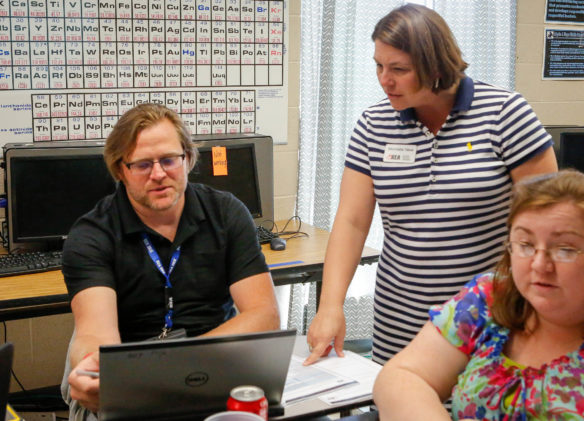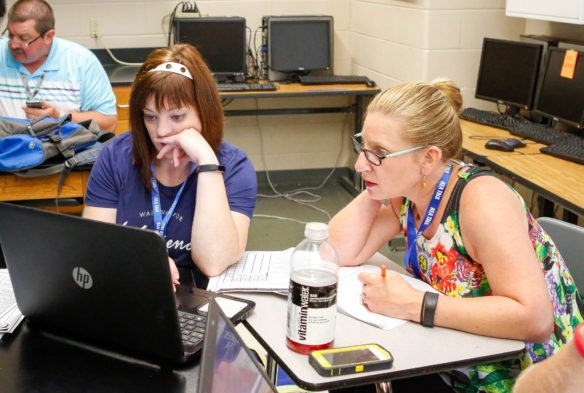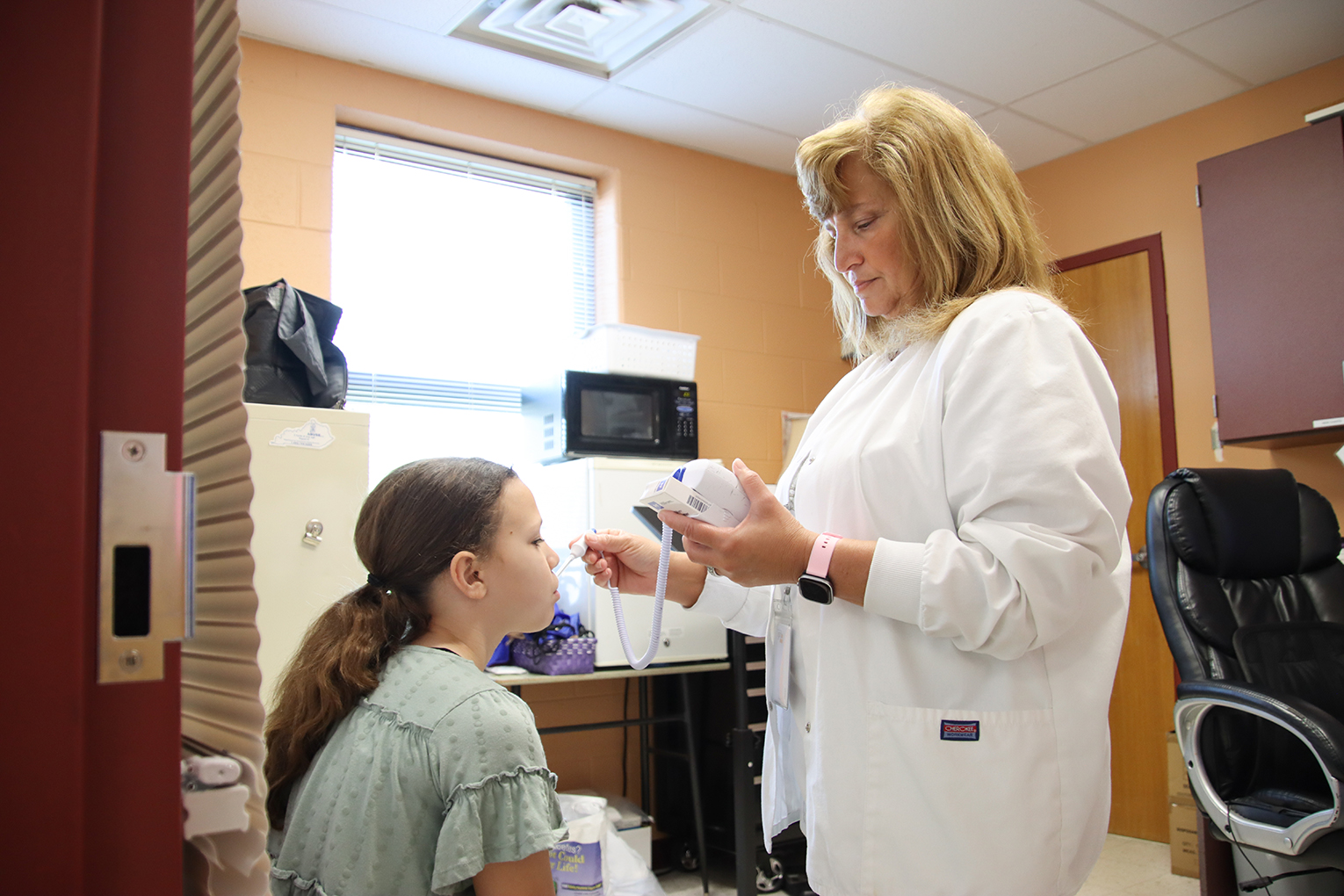
Scott King, a 7th-grade science teacher at Camp Ernst Middle School (Boone County), analyzed his school’s TELL survey results with Michelle New, Kentucky Education Association director of professional excellence, at KEA’s TALK conference. Teachers delved into their school’s data to find areas for celebration and opportunities for improvement.
Photo by Brenna Kelly, June 13, 2017.
By Brenna R. Kelly
Brenna.kelly@education.ky.gov
Educators across the state say that their schools and districts have made a marked improvement over the past two years in providing professional learning and allowing teachers to use that new-found knowledge in the classroom.
That was one of the findings from the biennial survey of working conditions in Kentucky public schools. A record 91 percent – 41,500 in all – of eligible Kentucky school-based certified educators responded to the 2017 Teaching, Empowering, Leading and Learning (TELL) survey, according to the New Teacher Center, which administers the survey.
The educators anonymously answered more than 130 questions about working conditions that affect teaching and learning, including student behavior, school leadership and facilities. The TELL results show that teachers are generally more positive about the conditions than they were in the 2015 survey.
“Because this is the fourth administration of the TELL survey in Kentucky, we have trend data to analyze,” said Christine Meisberger, manager of the Teacher and Leader Effectiveness Branch for the Kentucky Department of Education. “There are many tools educators can choose from to help them sift through the data. Once a tool is chosen, most schools find it helpful to reference the “Teaching Conditions Continuum” from the Kentucky Teaching Condition Standards. The Continuum can help schools plan what actions to take over the next two years to reach a goal.”
During the Kentucky Education Association’s (KEA) 2017 TALK conference in June, Meisberger and KEA officials Michelle New and Eddie Campbell helped teachers delve into their school’s data to find areas for celebration and opportunities for improvement.
Elizabeth King and Katie Gibbons, teachers at Hinsdale Elementary (Kenton County), looked at their school’s data in hopes of helping their new principal target areas for improvement.
“We went through first and just looked at our results for the last two (surveys) and made some notes about the ones that had dropped significantly,” King said. “We want to see what we think is our highest need to make our school better.”

Katie Gibbons (left) and Elizabeth King, teachers at R.C. Hindsdale Elementary (Kenton County), examine their school’s responses to the TELL survey. The teachers, who are also on the elementary’s school-based decision making council, were looking for areas where the school can improve.
Photo by Brenna Kelly, June 13, 2017.
Gibbons and King, who both have children who attend the school, also serve on Hinsdale’s school-based decision making council. All 38 of the school’s teachers participated in the TELL survey. The teachers compared Hinsdale’s responses with the district and state averages to find areas where their school was an outlier.
“We are very invested,” King said. “We want to decide on what positive changes we want to make at our school.”
Campbell, KEA vice president, said teachers often find examining their school’s data empowering.
“There’s lots and lots of information that you can glean by looking at the data from the TELL Survey,” he said. “Teachers can go to their administrators with the data showing that something is an issue that is going to change the school’s culture, which in turn is going to change student learning because the educators feel like their voices are actually being heard.”
Simon Kenton High School (Kenton County) teacher Leann Lewis said she was happy to see that changes the administration made after the 2015 survey were making a difference in this year’s results.
“They looked at our data and made some adjustments, for example, in non-instructional time, in our resources and in our teacher leadership and school leadership,” Lewis said. “Because of the survey, I feel like I have a say in that and I think all teachers do. It’s kind of put us on the level of professionalism that we should have been at.”
Lewis also was pleased to see that her school’s rate of agreement about managing student conduct increased after the school expanded its Positive Behavior Interventions and Supports (PBIS) program. Simon Kenton had an 85.3 percent rate of agreement for the student conduct category – 2.7 percentage points higher than the state’s rate of agreement.
In fact, student conduct was the only category to decrease in rate of agreement statewide from 2015 to 2017. The average rate of agreement for the category fell 2 percentage points. The biggest drop in agreement came in a question about whether students follow the rules. Only 74 percent of educators who responded agreed that students follow the rules of conduct at their school, a 4.8 percent drop from 2015.
“TELL is all about taking the data and doing something with it,” said New, KEA director of professional excellence. That’s why KEA offered a six-hour classroom management track at the TALK conference. Teachers learned how to interact with and react to their students in one session, and then learned specific strategies to manage their classrooms in another session.
In the TELL survey’s seven other categories, the rate of educator agreement increased or stayed the same from the 2015 survey, said Dawn Shephard, program director at the New Teacher Center.
The category of questions about professional learning saw the greatest increase from 2015 – up 4 percentage points in the rate of agreement. A question in that category about whether professional learning is evaluated and the results communicated to teachers saw the biggest jump of any question in the survey – a 10.1 percentage point increase from 2015.
Teachers had the highest rate of agreement on questions about instructional practices and support, facilities and resources, school leadership and professional development. The survey showed the lowest rates of agreement on questions about use of time, however the rate of agreement in that category increased 3.2 percentage points from 2015.
Source: 2017 TELL Kentucky Survey
“Use of time was shown to be the most challenged construct, which is also shown to be the case nationally,” Shephard said.
The survey also shows how the teaching conditions at a school affect a teacher’s choice to stay at that school or seek out a new job. The survey asks teachers if they plan to stay at their school or move on and the data is cross-referenced with answers about working conditions.
For example, 81 percent of teachers who planned to stay at their school said that their school leadership creates an atmosphere of trust and mutual respect, while just 34 percent of teachers who planned to leave their school agreed that their school leadership creates an atmosphere of trust and respect.
“What that shows is that leadership is extremely important in school settings and that we should drill down on that,” Shephard said. “And that there needs to be an atmosphere of mutual respect in order for educators to survive and thrive.”
KEA can offer help to schools or districts who want to delve into their data and come up with plans of action, New said.
“We know that these are the things that impacts student learning,” she said. “If you don’t have a culture and a climate in your building that is safe, warm, inviting and open, students are not going to learn.”
MORE INFO …
Michelle New Michelle.New@Kea.org
Eddie Campbell Eddie.Campbell@kea.org
Christine Meisberger Christine.Mesiberger@education.ky.gov
Dawn Shephard https://newteachercenter.org/contact/




Leave A Comment